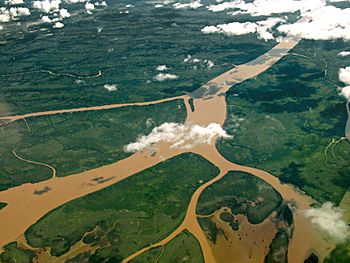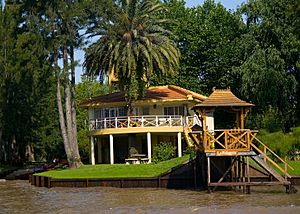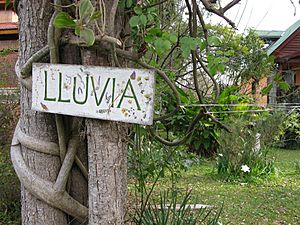Paraná Delta facts for kids
Quick facts for kids Paraná Delta |
|
|---|---|

Aerial view of the Lower Delta, north of Buenos Aires
|
|
| Country | Argentina |
| Physical characteristics | |
| Length | 320 kilometres (200 mi) |
| Basin features | |
| Basin size | 14,000 square kilometres (5,400 sq mi) |
| Official name: Delta del Paraná | |
| Designated: | 3 October 2015 |
| Reference #: | 2255 |

The Paraná Delta (Spanish: Delta del Paraná) is a special land area in Argentina. It's where the Paraná River splits into many smaller rivers and streams, creating lots of islands. These islands are often called the Islas del Paraná.
The Paraná River flows from north to south. As it gets closer to the Río de la Plata, it spreads out. This forms a wide, flat area of land called a flood plain. This area stretches across parts of Entre Ríos Province, Santa Fe Province, and Buenos Aires Province.
The delta covers about 14,000 square kilometres (5,400 sq mi), which is a huge area! It starts to form between the cities of Santa Fe and Rosario. Here, the river divides into many branches, forming a network of islands and wetlands. Most of the delta is in Entre Ríos Province. Some parts are also in the northern area of Buenos Aires Province.
The Paraná Delta is usually split into three main parts:
- The Upper Delta: This part goes from the Diamante – Puerto Gaboto line down to Villa Constitución.
- The Middle Delta: This section stretches from Villa Constitución to the Ibicuy Islands.
- The Lower Delta: This is the part from the Ibicuy Islands to where the river meets the Río de la Plata.
The delta is about 320 kilometres (200 mi) long. Its width changes, from 18 to 60 kilometres (11 to 37 mi) wide. It carries a lot of sediment (dirt and sand) from the river, which helps the delta grow. It's unique because it's the only river delta in the world that meets another river, not the sea.
The Lower Delta was one of the first places where people settled in this region. Today, many people live there. It's an important area for farming and factories in Argentina. It also has several big ports. The main part of the Paraná River flows along the west side of the delta. Large ships can travel on this part of the river.
Contents
Exploring the Delta's Rivers
The Paraná Delta has many different river branches. Some of the most important ones are the Paraná Pavón, the Paraná Ibicuy, the Paraná de las Palmas, the Paraná Guazú, and the smaller Paraná Miní and Paraná Bravo.
The Paraná Pavón is one of the first big branches. It twists and turns, starting on the eastern side, across from Villa Constitución. Between the main Paraná River and the Paraná Pavón are the Lechiguanas Islands. The Paraná Pavón flows east, then south, and becomes the Ibicuy River. The Ibicuy River then forms the smaller Paranacito River, which flows into the Uruguay River near Villa Paranacito.
The Paraná de las Palmas starts near where the Paraná Ibicuy ends, downstream from Baradero. It flows west into Buenos Aires province, then turns southeast again. The main river continues as another large branch, the Paraná Guazú. The Paraná Guazú also has two branches that flow east into Entre Ríos: first the Paraná Bravo, and then the Paraná Miní.
Understanding the Delta's Climate
Because the Paraná Delta is very flat and has a lot of water, it has a special climate. It's different from the rest of the Pampas region around it. Like the rest of the area, it has four clear seasons. However, the Delta has slightly colder nights, milder winters, and more humidity. This allows some plants and animals that like warmer weather to grow here.
Summer (December to February) Summers are hot and often humid. Daytime temperatures are usually between 18 and 22 °C (64 and 72 °F), and nights are between 16 and 20 °C (61 and 68 °F). Heat waves can happen, but they are usually not as strong as in central Argentina. Temperatures usually don't go much higher than 36 °C (97F). Thunderstorms are common and can bring heavy rain and cooler weather. Sometimes, cool winds called Pampero blow, bringing a break from the heat.
Autumn (March to May) March starts to feel cooler than summer. April often has very pleasant weather, with highs from 21 °C (70F) to 25 °C (77F) and nights from 10 °C (50F) to 14 °C (57F). By May, it generally feels cool, with chilly nights.
Winter (Late May to Late August) Winters are from late May to late August. Daytime temperatures are usually between 13 °C (55F) and 18 °C (64F). Nights are colder, from 3 °C (37F) to 7 °C (45F). There is less rain, but more clouds and often fog. Sometimes, there are short, mild periods when temperatures can reach 25 °C (77F). Frost can happen several times a year, but temperatures rarely drop below -3 °C (27F). However, the windy and humid weather can make it feel much colder than it actually is.
Spring (September to November) Spring is usually lovely, but the weather can change very quickly. Summer-like and winter-like temperatures can happen in the same week. There can also be a big difference between day and night temperatures. This season is also more likely to have strong storms. October has similar average temperatures to April, but with slightly cooler nights. Extreme heat or cold can happen, with frost sometimes occurring, or temperatures reaching 35 °C (95F).
The amount of rain in the delta ranges from 1,000 to 1,400 millimetres (39 to 55 in) per year. There are two times of the year when it rains the most: late spring/early summer and late summer/early autumn. Winter is drier but has more cloudy days.
Exploring the Delta's Ecology and Wildlife


The flat, watery land of the river is part of the Paraná Delta and Islands Ecoregion. The natural environment, especially in the Lower Delta, has changed a lot over time. This is due to things like cutting down trees, hunting, fishing, and new types of plants and animals being brought in. Pollution from homes and factories has also caused damage.
The delta is home to many amazing animals. These include the marsh deer, the capybara (a large rodent), the neotropical river otter, the Pampas cat, and the coypu. You might also find the red-faced guan, a type of bird. Some of these animals are in danger of disappearing.
Protected Areas in the Delta
To help protect this special environment, several areas in the delta have been set aside.
The Isla Botija Nature Reserve was one of the first protected areas created in the lower Paraná Delta in 1958.
The Predelta National Park was created in 1992 to protect a part of the Upper Delta. It is in the southwest of Entre Ríos, about 6 kilometres (4 mi) south of Diamante. This park covers 24.58 square kilometres (9.49 sq mi). It includes low-lying islands that often flood, along with lagoons and swamps.
The Paraná Delta Biosphere Reserve is a large protected area recognized by UNESCO in 2000. It covers 886 square kilometres (342 sq mi), with 106 square kilometres (41 sq mi) being a core area that is strictly protected. This reserve is found just north of Buenos Aires. It is very rich in different kinds of plants and animals. Some species here reach the southernmost limit of where they can live, which makes the area important for protecting genetic diversity.
People in this part of the delta mostly harvest willow trees for business. There are not many people living here, only about 3,600 in 2001. The Biosphere Reserve aims to help the local economy grow in a way that is good for nature and culture. It also supports research and studies of the ecosystem. The goal is to encourage projects that help the delta grow in a sustainable way, like organic farming.
See also
 In Spanish: Delta del Paraná para niños
In Spanish: Delta del Paraná para niños
- Tigre, Buenos Aires
- Villa Paranacito, Entre Ríos




